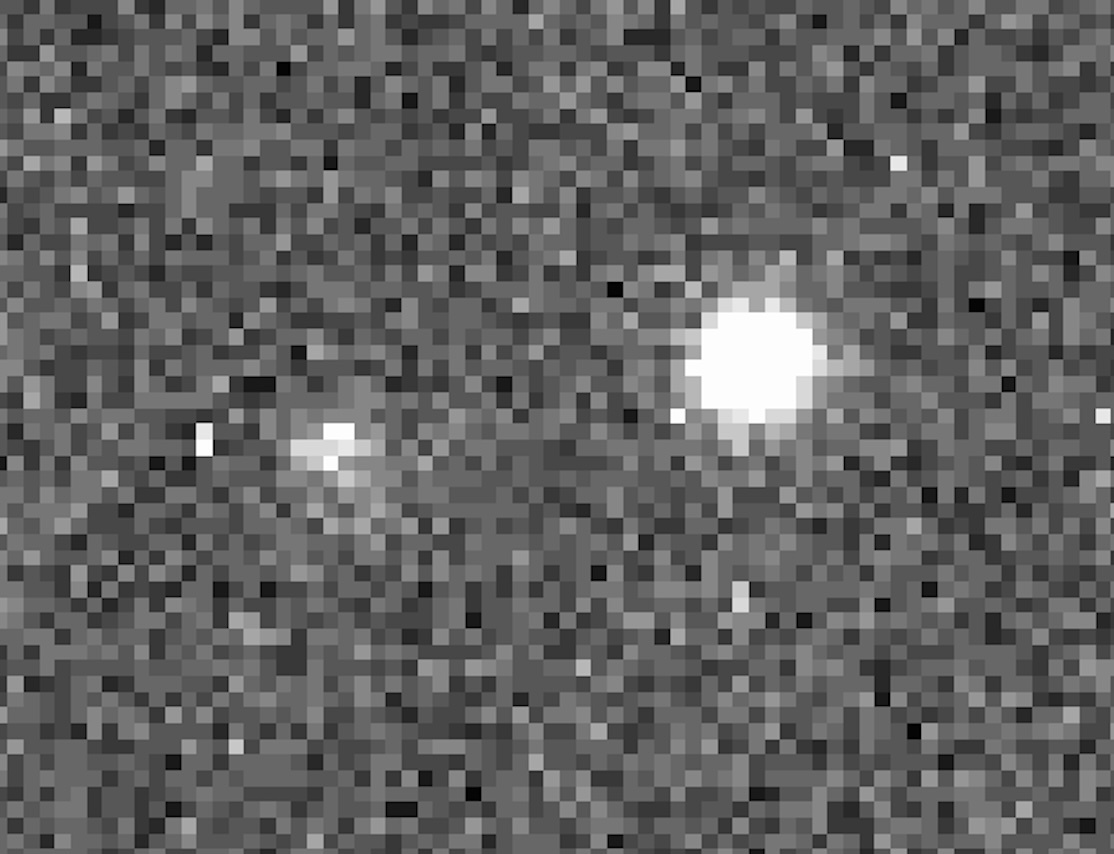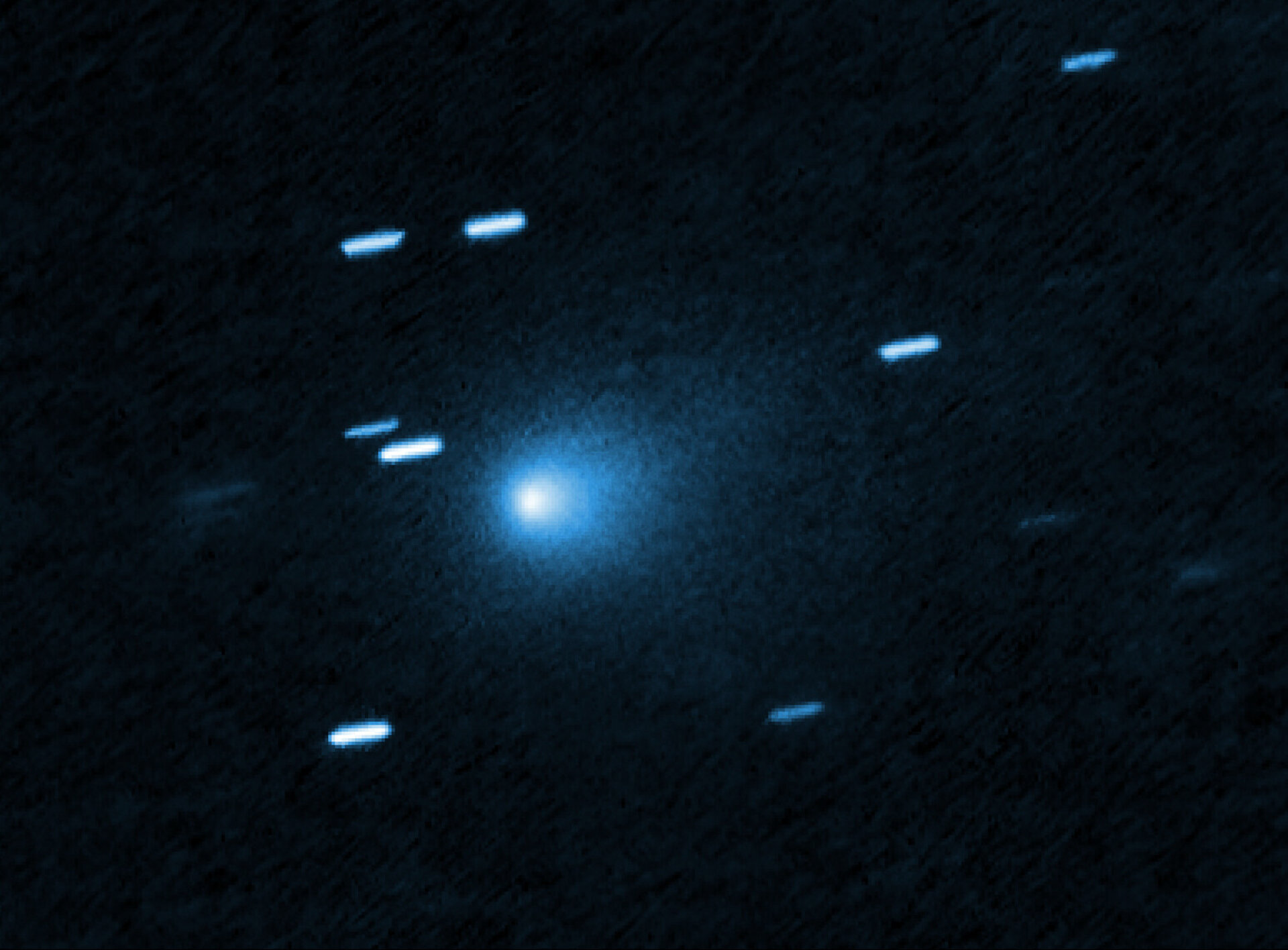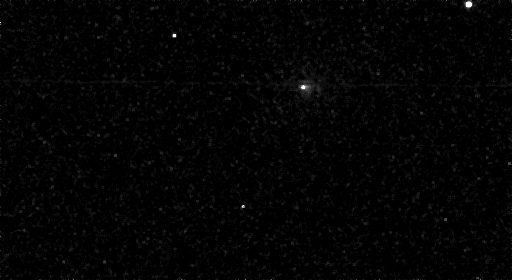8.10.2025

Comet 3I/ATLAS – frequently asked questions
Komet 3I/ATLAS – häufig gestellte Fragen

What is comet 3I/ATLAS?
Comet 3I/ATLAS is a newly identified interstellar object, meaning that it comes from outside our Solar System. It is only the third of its kind ever observed, following 1I/ʻOumuamua in 2017 and 2I/Borisov in 2019.
Why is it important?
These comets are absolutely foreign. Every planet, moon, asteroid, comet and lifeform in our Solar System share a common origin. But interstellar comets are true outsiders, carrying clues about the formation of worlds far beyond our own.
When and how was it detected?
It was first spotted on 1 July 2025 by the Asteroid Terrestrial-impact Last Alert System (ATLAS) telescope in Río Hurtado, Chile. Its unusual trajectory immediately raised suspicions that it originated from interstellar space. This was later confirmed by astronomers around the world, and the object was given its formal designation: 3I/ATLAS.
Was ist der Komet 3I/ATLAS?
Der Komet 3I/ATLAS ist ein neu identifiziertes interstellares Objekt, das heißt, er stammt von außerhalb unseres Sonnensystems. Er ist erst der dritte seiner Art, der jemals beobachtet wurde, nach 1I/ʻOumuamua im Jahr 2017 und 2I/Borisov im Jahr 2019.
Warum ist er wichtig?
Diese Kometen sind absolut fremdartig. Jeder Planet, Mond, Asteroid, Komet und jede Lebensform in unserem Sonnensystem hat einen gemeinsamen Ursprung. Doch interstellare Kometen sind wahre Außenseiter und tragen Hinweise auf die Entstehung von Welten weit jenseits unserer eigenen in sich.
Wann und wie wurde er entdeckt?
Er wurde erstmals am 1. Juli 2025 vom ATLAS-Teleskop (Asteroid Terrestrial-impact Last Alert System) in Río Hurtado, Chile, entdeckt. Seine ungewöhnliche Flugbahn ließ sofort den Verdacht aufkommen, dass er aus dem interstellaren Raum stammt. Dies wurde später von Astronomen auf der ganzen Welt bestätigt und das Objekt erhielt seine offizielle Bezeichnung: 3I/ATLAS.
Why the name ‘3I/ATLAS’?
Traditionally, comets were named after the person who discovered them. Nowadays, we follow a coded naming system developed by the International Astronomical Union. The first letter indicates the category that the comet falls under – in this case ‘I’ for ‘Interstellar’. The number ‘3’ before the ‘I’ indicates that the comet is the third of its kind. The word ‘ATLAS’ refers to the programme that operates the telescope that first spotted the comet.
Find out more about how comets are named here.
Can you give some quick facts about the comet?
Size: a few hundred metres to a few kilometres across
Speed: roughly 210 000 km/h – the highest ever recorded for a Solar System visitor
Age: billions of years old – indicated by its breathtaking speed, evidence that it has been drifting through space for a very long time
Closest approach to Earth: 240 million km
Closest approach to Mars: 30 million km
Does it pose a danger to Earth?
The comet will come no closer than 240 million km – that’s over 1.5 times the distance between Earth and the Sun. During its closest approach to the Earth, it will be on the other side of the Sun. It poses no danger to our planet or any other planets in the Solar System.
Is ESA’s Planetary Defence Office tracking the comet?
Yes. ESA's Planetary Defence Office responded promptly to the discovery, with ESA astronomers contributing to global efforts to track the comet’s path using telescopes in Hawaii, Chile and Australia. They are also looking for evidence of its existence in older data – a process known as ‘precovery’.
These efforts are part of ESA’s broader mission to detect, track, and characterise near-Earth objects – though 3I/ATLAS is not considered one, due to its distance from our planet.
By the time the comet reaches its closest point to Earth, it will be hidden behind the Sun. It is due to reappear in late November, offering astronomers another window for study.
Warum der Name „3I/ATLAS“?
Traditionell wurden Kometen nach ihrem Entdecker benannt. Heute folgt man einem von der Internationalen Astronomischen Union entwickelten kodierten Benennungssystem. Der erste Buchstabe gibt die Kategorie des Kometen an – in diesem Fall „I“ für „Interstellar“. Die Zahl „3“ vor dem „I“ zeigt an, dass es sich um den dritten Kometen seiner Art handelt. Das Wort „ATLAS“ bezieht sich auf das Programm, das das Teleskop betreibt, mit dem der Komet erstmals entdeckt wurde.
Mehr zur Benennung von Kometen erfahren Sie hier.
Können Sie uns kurz etwas über den Kometen erzählen?
Größe: wenige hundert Meter bis wenige Kilometer Durchmesser
Geschwindigkeit: rund 210.000 km/h – die höchste jemals für einen Besucher des Sonnensystems gemessene Geschwindigkeit
Alter: Milliarden Jahre – seine atemberaubende Geschwindigkeit deutet darauf hin, dass er schon sehr lange durchs All driftet
Nächste Annäherung an die Erde: 240 Millionen km
Nächste Annäherung an den Mars: 30 Millionen km
Stellt er eine Gefahr für die Erde dar?
Der Komet wird sich der Erde auf höchstens 240 Millionen km nähern – das entspricht mehr als der 1,5-fachen Entfernung zwischen Erde und Sonne. Bei seiner größten Annäherung an die Erde befindet er sich auf der anderen Seite der Sonne. Er stellt keine Gefahr für unseren Planeten oder andere Planeten im Sonnensystem dar.
Verfolgt das Planetary Defence Office der ESA den Kometen?
Ja. Das Planetary Defence Office der ESA reagierte umgehend auf die Entdeckung. ESA-Astronomen beteiligten sich an den weltweiten Bemühungen, die Bahn des Kometen mit Teleskopen auf Hawaii, Chile und Australien zu verfolgen. Sie suchen auch in älteren Daten nach Hinweisen auf seine Existenz – ein Prozess, der als „Precovery“ bezeichnet wird.
Diese Bemühungen sind Teil der umfassenderen Mission der ESA zur Erkennung, Verfolgung und Charakterisierung erdnaher Objekte – obwohl 3I/ATLAS aufgrund seiner Entfernung von unserem Planeten nicht als solches gilt.
Wenn der Komet seinen erdnächsten Punkt erreicht, wird er hinter der Sonne verborgen sein. Er wird voraussichtlich Ende November wieder auftauchen und den Astronomen so ein weiteres Zeitfenster für Studien bieten.
What will happen to 3I/ATLAS in the coming months?
3I/ATLAS is an active comet. Observations by the NASA/ESA Hubble Space Telescope already capture a dust plume ejected from the Sun-warmed side of the comet, and the hint of a dust tail streaming away from its nucleus. Comets originating within our own Solar System display similar behaviour.
As the comet continues to approach the Sun, it will likely lose more and more mass as frozen gases transform into vapour, carrying dust and ice into space. Observations by the NASA/ESA/CSA James Webb Space Telescope of the coma, or ‘halo’, surrounding the comet already reveal carbon dioxide, water, carbon monoxide, carbonyl sulphide and water ice being released as the comet heats up.
Find out more about the structure of a comet here.
Is ESA planning to visit 3I/ATLAS?
The comet will make its closest approach to the Sun in late October 2025, passing just inside the orbit of Mars. After that moment, it will speed away from us. This is far too soon, and the comet is moving far too quickly, to contemplate sending a spacecraft to visit or land on it. Instead, we are observing 3I/ATLAS from a distance with our space telescopes and planetary missions.
What ESA missions will observe 3I/ATLAS?
The comet has already been observed by space telescopes close to Earth, including the NASA/ESA Hubble Space Telescope and the NASA/ESA/CSA James Webb Space Telescope. In the coming months, ESA will turn interplanetary voyagers such as Mars Express, ExoMars Trace Gas Orbiter and the Jupiter Icy Moons Explorer (Juice) in the direction of the comet to make further observations with eyes from all over the Solar System. 3I/ATLAS will pass through the field of view of the ESA/NASA Solar and Heliospheric Observatory (SOHO), but we expect it to be much too faint to be visible.
When and how will ESA’s Mars’s missions observe 3I/ATLAS?
ESA’s Mars Express and ExoMars Trace Gas Orbiter (TGO) will observe the comet with several instruments around its closest approach to Mars on 3 October 2025. On that date, 3I/ATLAS will be around 30 million km from Mars.
The instruments turning their eyes to the comet include Mars Express’s High Resolution Stereo Camera (HRSC) and ExoMars TGO’s Colour and Stereo Surface Imaging System (CaSSIS) – both cameras that are typically used to photograph the Red Planet. We will also attempt to measure the spectrum of light from the comet using Mars Express’s OMEGA and SPICAM spectrometers and TGO’s NOMAD spectrometer, though it is not certain whether the comet and its tail will be bright enough for a full spectral characterisation.
The observations may give us hints about the volatile activity and composition of 3I/ATLAS. As Mars Express and ExoMars TGO are designed to image the martian surface just a few hundred to thousand kilometres below, we do not expect spectacular images of a (relatively) small comet 30 million km away; the comet itself will cover less than a pixel in the images. We expect better images of the halo of gas around the comet and the tail that streams behind it. The success of the observations also depends on how bright the comet is as it approaches the Sun, which in turn depends largely on how much water it contains and how much escapes in the form of a tail.
When and how will ESA’s Juice mission observe 3I/ATLAS?
Of all ESA interplanetary spacecraft, the Jupiter Icy Moons Explorer (Juice) is likely to have the best view of 3I/ATLAS in a very active state. Juice will attempt observations in November 2025 using several instruments, including cameras, spectrometers and a particle sensor. Coordination with NASA’s Europa Clipper mission is being considered, in particular to observe using the twin ultraviolet spectrographs (one on each spacecraft).
As Juice is currently close to the Sun, it is using its main high-gain antenna as a heat shield. It is using its smaller medium-gain antenna to send data back to Earth at a much lower rate. It is also far from Earth, on the other side of the Sun. Therefore, we don’t expect to receive data from Juice’s observations of 3I/ATLAS until February 2026.
Is ESA planning any missions to visit a comet in the future?
Following in the footsteps of ESA’s Rosetta mission, which landed on Comet 67P in 2014, ESA is currently developing the next-generation comet mission, Comet Interceptor. Comet Interceptor will be the first mission to visit a comet coming directly from the outer reaches of the Sun's realm, carrying material untouched since the dawn of the Solar System. It is also possible – though very unlikely given their rarity – that Comet Interceptor could visit an interstellar comet.
Was wird in den kommenden Monaten mit 3I/ATLAS geschehen?
3I/ATLAS ist ein aktiver Komet. Beobachtungen des Hubble-Weltraumteleskops der NASA/ESA zeigen bereits eine Staubwolke, die von der sonnenerwärmten Seite des Kometen ausgestoßen wird, sowie die Andeutung eines Staubschweifes, der von seinem Kern ausströmt. Kometen aus unserem eigenen Sonnensystem zeigen ein ähnliches Verhalten.
Mit zunehmender Annäherung an die Sonne wird der Komet wahrscheinlich zunehmend an Masse verlieren, da sich gefrorene Gase in Dampf verwandeln und Staub und Eis in den Weltraum tragen. Beobachtungen des James-Webb-Weltraumteleskops der NASA/ESA/CSA der Koma, auch „Halos“ genannt, die den Kometen umgibt, zeigen bereits, dass bei der Erwärmung des Kometen Kohlendioxid, Wasser, Kohlenmonoxid, Carbonylsulfid und Wassereis freigesetzt werden.
Mehr über den Aufbau eines Kometen erfahren Sie hier.
Plant die ESA einen Besuch bei 3I/ATLAS?
Der Komet wird der Sonne Ende Oktober 2025 am nächsten kommen und dabei knapp innerhalb der Marsumlaufbahn vorbeiziehen. Danach wird er sich mit hoher Geschwindigkeit von uns entfernen. Dies ist viel zu früh, und der Komet bewegt sich viel zu schnell, um eine Raumsonde zu ihm zu schicken oder auf ihm zu landen. Stattdessen beobachten wir 3I/ATLAS aus der Ferne mit unseren Weltraumteleskopen und Planetenmissionen.
Welche ESA-Missionen werden 3I/ATLAS beobachten?
Der Komet wurde bereits von erdnahen Weltraumteleskopen beobachtet, darunter das Hubble-Weltraumteleskop der NASA/ESA und das James-Webb-Weltraumteleskop der NASA/ESA/CSA. In den kommenden Monaten wird die ESA interplanetare Raumsonden wie Mars Express, den ExoMars Trace Gas Orbiter und den Jupiter Icy Moons Explorer (Juice) auf den Kometen ausrichten, um weitere Beobachtungen aus dem gesamten Sonnensystem durchzuführen. 3I/ATLAS wird das Sichtfeld des Solar and Heliospheric Observatory (SOHO) von ESA und NASA passieren, dürfte aber viel zu schwach sein, um sichtbar zu sein.
Wann und wie werden die Marsmissionen der ESA 3I/ATLAS beobachten?
Der Mars Express und der ExoMars Trace Gas Orbiter (TGO) der ESA werden den Kometen bei seiner größten Annäherung an den Mars am 3. Oktober 2025 mit mehreren Instrumenten beobachten. Zu diesem Zeitpunkt wird 3I/ATLAS etwa 30 Millionen Kilometer vom Mars entfernt sein.
Zu den Instrumenten, die den Kometen im Blick haben, gehören die hochauflösende Stereokamera (HRSC) von Mars Express und das Colour and Stereo Surface Imaging System (CaSSIS) von ExoMars TGO – beides Kameras, die typischerweise zur Fotografie des Roten Planeten eingesetzt werden. Wir werden außerdem versuchen, das Lichtspektrum des Kometen mit den OMEGA- und SPICAM-Spektrometern von Mars Express sowie dem NOMAD-Spektrometer von TGO zu messen. Es ist jedoch nicht sicher, ob der Komet und sein Schweif hell genug für eine vollständige spektrale Charakterisierung sein werden.
Die Beobachtungen könnten uns Hinweise auf die flüchtige Aktivität und Zusammensetzung von 3I/ATLAS geben. Da Mars Express und ExoMars TGO darauf ausgelegt sind, die Marsoberfläche in nur wenigen hundert bis tausend Kilometern Entfernung abzubilden, erwarten wir keine spektakulären Bilder eines (relativ) kleinen Kometen in 30 Millionen Kilometern Entfernung; der Komet selbst wird weniger als einen Pixel in den Bildern einnehmen. Wir erwarten bessere Bilder des Gashalos um den Kometen und des dahinter fließenden Schweifes. Der Erfolg der Beobachtungen hängt auch davon ab, wie hell der Komet bei Annäherung an die Sonne ist, was wiederum maßgeblich davon abhängt, wie viel Wasser er enthält und wie viel davon in Form eines Schweifes entweicht.
Wann und wie wird die ESA-Mission Juice 3I/ATLAS beobachten?
Von allen interplanetaren Raumsonden der ESA dürfte der Jupiter Icy Moons Explorer (Juice) den besten Blick auf 3I/ATLAS in seinem sehr aktiven Zustand bieten. Juice wird im November 2025 mit verschiedenen Instrumenten, darunter Kameras, Spektrometern und einem Partikelsensor, Beobachtungen durchführen. Eine Koordination mit der Europa-Clipper-Mission der NASA wird in Erwägung gezogen, insbesondere um die Beobachtungen mit den beiden Ultraviolett-Spektrographen (einer an Bord jeder Sonde) durchzuführen.
Da Juice sich derzeit in Sonnennähe befindet, nutzt sie ihre Hauptantenne mit hoher Verstärkung als Hitzeschild. Mit ihrer kleineren Antenne mit mittlerer Verstärkung sendet sie Daten mit deutlich geringerer Geschwindigkeit zur Erde. Zudem befindet sie sich auf der anderen Seite der Sonne, weit von der Erde entfernt. Daher erwarten wir Daten von Juices Beobachtungen von 3I/ATLAS erst im Februar 2026.
Plant die ESA zukünftige Missionen zu Kometenbesuchen?
Nach der Rosetta-Mission der ESA, die 2014 auf dem Kometen 67P landete, entwickelt die ESA derzeit die Kometenmission der nächsten Generation: Comet Interceptor. Comet Interceptor wird die erste Mission sein, die einen Kometen besucht, der direkt aus den äußeren Bereichen der Sonne kommt und Material mit sich führt, das seit der Entstehung des Sonnensystems unberührt geblieben ist. Es ist auch möglich – wenn auch aufgrund ihrer Seltenheit sehr unwahrscheinlich –, dass Comet Interceptor einen interstellaren Kometen besucht.
Quelle: ESA
+++
ESA observations of interstellar comet 3I/ATLAS

Hubble
The European Space Agency (ESA) reacted promptly to the discovery of comet 3I/ATLAS on 1 July 2025. Soon after they were alerted to its existence by automated detection systems, ESA astronomers began using ground-based telescopes in Hawaii, Chile, and Australia to monitor its progress.
Since then, the comet has been observed by space telescopes close to Earth, including the NASA/ESA Hubble Space Telescope and the NASA/ESA/CSA James Webb Space Telescope.
In the coming months, ESA will turn interplanetary voyagers such as Mars Express, ExoMars Trace Gas Orbiter and the Jupiter Icy Moons Explorer (Juice) in the direction of the comet to make further observations from excellent vantage points.
Quelle: ESA
+++
ExoMars Trace Gas Orbiter observes comet 3I/ATLAS – GIF

On 3 October, ESA’s ExoMars Trace Gas Orbiter (TGO) turned its eyes towards interstellar comet 3I/ATLAS as it passed close to Mars.
Together with Mars Express, ExoMars TGO had the closest view of the comet of all ESA spacecraft. It looked towards the interstellar interloper from 30 million km away during its closest approach to the Red Planet.
ExoMars TGO used its dedicated Colour and Stereo Surface Imaging System (CaSSIS) to capture the comet, an instrument normally used to photograph the bright surface of Mars from a few hundred to a few thousand kilometres away.
Comet 3I/ATLAS is the slightly fuzzy white dot moving downwards near the middle of the image. Despite not being designed to capture something so far away, ExoMars TGO revealed the coma of gas and dust surrounding the icy-rocky nucleus.
For this observation, scientists stacked multiple five-second exposures to reveal 3I/ATLAS.
Quelle: ESA
+++
ESA’s ExoMars and Mars Express observe comet 3I/ATLAS
Between 1 and 7 October, ESA’s ExoMars Trace Gas Orbiter (TGO) and Mars Express spacecraft turned their eyes towards interstellar comet 3I/ATLAS, as it passed close to Mars.
The two Mars orbiters had the closest view of the comet of all ESA spacecraft. During its closest approach to the Red Planet on 3 October, the interstellar interloper was 30 million km away from them.
Each spacecraft used its dedicated camera to watch the comet pass. Both cameras are designed to photograph the bright surface of Mars just a few hundred to a few thousand km below. Scientists were unsure what to expect from observations of a relatively dim target so far away.
ExoMars TGO captured the series of images shown in the GIF below with its Colour and Stereo Surface Imaging System (CaSSIS). Comet 3I/ATLAS is the slightly fuzzy white dot moving downwards near the centre of the image. This dot is the centre of the comet, comprising its icy-rocky nucleus and its surrounding coma.
CaSSIS could not distinguish the nucleus from the coma, because 3I/ATLAS was too far away. Imaging this kilometre-wide nucleus would have been as impossible as seeing a mobile phone on the Moon from Earth.
But the coma, measuring a few thousand kilometres across, is clearly visible. The coma is created as 3I/ATLAS approaches the Sun. The Sun’s heat and radiation is bringing the comet to life, causing it to release gas and dust, which collects as this halo surrounding the nucleus.
The full size of the coma could not be measured by CaSSIS because the brightness of the dust decreases quickly with distance from the nucleus. This means that the coma fades into the noise in the image.
Typically, material from the coma is swept into a long tail, which can grow up to millions of kilometres long as the comet moves closer to the Sun. The tail is much dimmer than the coma. We can’t see the tail in the CaSSIS images, but it may become more visible in future observations as the comet continues to heat up and release more ice.
Nick Thomas, Principal Investigator of the CaSSIS camera explains, “This was a very challenging observation for the instrument. The comet is around 10 000 to 100 000 times fainter than our usual target.”
The work continues
3I/ATLAS has not yet revealed itself in the Mars Express images, partly because these were taken with an exposure time of just 0.5 seconds (the maximum limit for Mars Express) compared to five seconds for ExoMars TGO.
Scientists will continue to analyse the data from both orbiters, including adding together several images from Mars Express to see if they can spot the faint comet.
They also tried to measure the spectrum of light from comet 3I/ATLAS using Mars Express’s OMEGA and SPICAM spectrometers, and ExoMars TGO’s NOMAD spectrometer. At this point, it is uncertain whether the coma and tail were bright enough for a spectral characterisation.
Scientists will keep analysing the data over the next weeks and months to try to figure out more about what 3I/ATLAS is made of and how it is behaving as it approaches the Sun.
Colin Wilson, Mars Express and ExoMars project scientist at ESA says: “Though our Mars orbiters continue to make impressive contributions to Mars science, it’s always extra exciting to see them responding to unexpected situations like this one. I look forward to seeing what the data reveals following further analysis.”
A rare visitor
Originating from outside our Solar System, comet 3I/ATLAS is only the third interstellar comet ever seen, following 1I/ʻOumuamua in 2017 and 2I/Borisov in 2019.
These comets are absolutely foreign. Every planet, moon, asteroid, comet and lifeform in our Solar System share a common origin. But interstellar comets are true outsiders, carrying clues about the formation of worlds far beyond our own.
Comet 3I/ATLAS was first spotted on 1 July 2025 by the Asteroid Terrestrial-impact Last Alert System (ATLAS) telescope in Río Hurtado, Chile. Since then, astronomers have used ground-based and space telescopes to monitor its progress and discover more about it.
Based on its trajectory, astronomers suspect that 3I/ATLAS could be the oldest comet ever observed. It may be three billion years older than the Solar System, which is itself already 4.6 billion years old.
What’s next?
Next month, we will observe the comet with our Jupiter Icy Moons Explorer (Juice). Though Juice will be further from 3I/ATLAS than our Mars orbiters were last week, it will see the comet just after its closest approach to the Sun, meaning that it will be in a more active state. We don’t expect to receive data from Juice’s observations until February 2026 – find out why in our FAQs.
Icy wanderers such as 3I/ATLAS offer a rare, tangible connection to the broader galaxy. To actually visit one would connect humankind with the Universe on a far greater scale. To this end, ESA is preparing the Comet Interceptor mission.
Comet Interceptor is due to launch in 2029 into a parking orbit, from where it will lie in wait for a suitable target – a pristine comet from the distant Oort Cloud that surrounds our Solar System, or, unlikely but highly appealing, an interstellar object like 3I/ATLAS.
Michael Kueppers, Comet Interceptor project scientist expands: “When Comet Interceptor was selected in 2019, we only knew of one interstellar object – 1I/ʻOumuamua, discovered in 2017. Since then, two more such objects have been discovered, showing large diversity in their appearance. Visiting one could provide a breakthrough in understanding their nature.”
While it remains improbable that we will discover an interstellar object that is reachable for Comet Interceptor, as a first demonstration of a rapid response mission that waits in space for its target, it will be a pathfinder for possible future missions to intercept these mysterious visitors.



